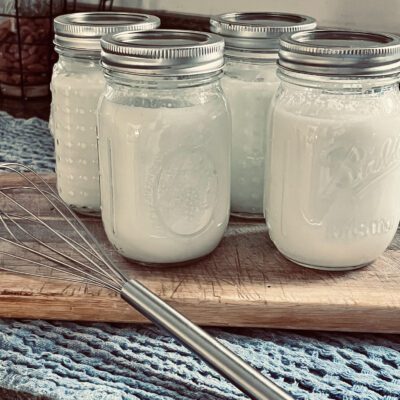Heat the Milk
Start by pouring the milk into a heavy-bottomed saucepan. Heat the milk over medium heat, stirring occasionally to prevent it from scorching. Use a thermometer to monitor the temperature. When the milk reaches about 180°F (82°C), remove it from the heat. This step helps to denature the proteins in the milk, which will result in a smoother texture.
Cool the Milk
After the milk has been heated, let it cool down to around 110°F (43°C). This is the ideal temperature for adding the yogurt starter, as it’s warm enough to activate the cultures but not so hot that it will kill them. You can speed up the cooling process by placing the pan in a cold water bath, making sure no water gets into the milk.
Add the Yogurt Starter
Once the milk has cooled to the correct temperature, whisk in your yogurt starter. If you're using store-bought Greek yogurt, take about 2 tablespoons of plain yogurt (with live cultures) and mix it with a small amount of the cooled milk to create a smooth paste. Then, whisk that paste back into the rest of the milk. This ensures an even distribution of cultures throughout the milk.
Culture the Yogurt
Now it’s time to let the yogurt culture. Pour the milk mixture into your glass jars or containers and cover them with a lid or plastic wrap. To maintain the proper temperature for fermentation, you can place the jars in an insulated cooler, a warm oven (with the light on), or use a yogurt maker. The yogurt needs to stay warm for 6 to 12 hours while it ferments. The longer it sits, the thicker and tangier it will become.
Check the yogurt at the 6-hour mark. If it’s not thick enough or tangy enough for your taste, let it sit longer. The ideal temperature for fermentation is around 100°F (38°C), so you may need to adjust based on the method you're using.
Refrigerate the Yogurt
Once your yogurt has reached the desired thickness and tanginess, it’s time to stop the fermentation process. Remove the jars from the warm environment and place them in the refrigerator. Let the yogurt chill for at least 2 hours to allow it to set fully.
Strain the Yogurt for Greek Yogurt
If you prefer the thick, creamy texture of Greek yogurt, you’ll need to strain the yogurt to remove excess whey. Place a fine-mesh strainer or cheesecloth over a bowl and pour the yogurt into it. Let it drain for about 1 to 2 hours, depending on how thick you want your yogurt. The longer it drains, the thicker the yogurt will be. You can save the whey for use in smoothies, baking, or as a base for soups.
Serve and Enjoy!
Once your yogurt is strained to your liking, it’s ready to enjoy. You can serve it plain, or top it with your favorite fruits, nuts, honey, or granola. Homemade Greek yogurt is perfect for breakfast, snacks, or as a healthy addition to smoothies and recipes.
